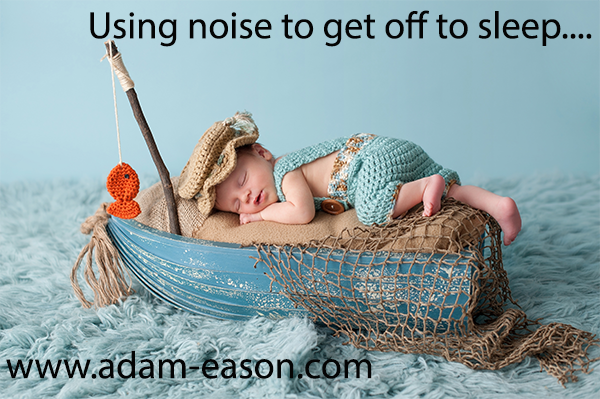When I first left home and headed for the bright lights of London for some work experience, with my first ever foray into the world of paid employment, such was my starting salary, that my first home was a rented maisonette with a train line running through the back of the garden. The parts of London underground that went overground also travelled on this track. I had not thought to fully assess this when eagerly securing the rental contract on this place… Boy was I in for a shock.
At first, having moved from pleasant, quite, tree-lined suburbia with my parents, I was now listening to trains sounding like they were ploughing through my front room every ten minutes or so. The furniture rattled at the same time!
That first night on my own, I tossed and turned and struggled to get any sleep at all such was the distraction… Thank goodness they stopped late at night… Although they started again pretty early in the morning.
A month or so later, I was sleeping like a baby every single night. I had adapted and it was absolutely fine. To be honest, I even missed that racket when I first moved away from it.
A number of years later, well, many years alter, when deciding to leave London and move to the south to move my business and life to the coast here in Bournemouth, I recall being in bed on the first morning and being woken by a very strange noise indeed. On the balcony of my apartment overlooking the sea was sat a seagull who was bellowing hard and loud.
Again, it took me a couple of weeks to get used to it… It is a sound I am very fond of today.
Many people who have to put up with noise at night, whether it is the noise of their partner snoring, or people on the street, or sounds of neighbours, can all be effectively slept through with some training – at least, if you have grown used to it. I mean, lots of people get themselves to sleep on planes and they are incredibly noisy. Of course, we are going to be alerted by noises requiring our attention or those that are strange and out of place – like a one-off crazy party in a flat above, which is likely to wake us regardless of our preparation.
Today’s self-hypnosis process is designed for dealing with noise, to help us work with noises to help ourselves get lulled to sleep, something Milton Erickson would refer to as utilization. It is aiming to help you have a skill for dealing with noise when looking to get to sleep, but also to condition yourself more readily to drift off even when there is a little bit of a distraction.
Simply follow these 7 Steps For Using Noise To Drift To Slumber:
Step One: Induce Hypnosis.
You can do so by any means you desire or know of. You can use the process in my Science of self-hypnosis book, use the free audio we give away on this website to practice or have a look at the following articles as and when you need them; they are basic processes to help you simply open the door of your mind:
Heavy Arm Self-Hypnosis Induction Method
Using Eye Fixation for Self-Hypnosis
The Chiasson Self-Hypnosis Method
Hand to Face Self-Hypnosis Induction
Using Magnetic Hands for Self-Hypnosis
The Coin Drop Self-Hypnosis Induction
However, with this process, an induction is potentially too much activity, so I teach my clients how to adopt a hypnotic mindset and simply have a mindset that is positive and expectant. Again, to really understand the cognitive set of the hypnotic mindset, go grab a copy of my Science of self-hypnosis book where it is explained in simple but comprehensive terms.
Once you have induced hypnosis, or just adopted the hypnotic mindset, move on to the next step.
Step Two: Tune in to the noises around you that are occurring. Just be aware of them. Do your best not to resist them, just hear them and engage with them for a short while. You can start to help the process along by telling yourself that each noise you hear relaxes you and takes you deeper inside your mind.
become aware of what kind of noise it is, how far away it is, the duration of it, and be aware of the qualities and distinctions.
When you have tuned in to the sounds going on around you, then move on to the next step.
Step Three: Now imagine lying down on an old wooden sailing boat that is out at sea.
Imagine the boat is rocking and the water is splashing against the sides of the boat making a noise. Imagine hearing the noise of sea birds, notice the noise of the wind rattling the mast and canvas, notice the creaking of the wooden structure and the rocking of the boat. Be aware of the bright light reflecting off the surface of the sea and shining from the sky.
Engage with this scene, become aware of the smell of the air, the taste of it even, perhaps sense the slight spray of the water every now and then. Tune in to all the variety of noises around you and notice how the boat creaks and groans, notice rumblings and how the ropes and lines rub against other structures.
Once you have really engaged your imagination with this scene in your own way, then move on to the next step.
Step Four: As you imagine those noises here at sea, start to fit them in with the noises going on around you in your real-life. Map the real-life noises into your imagined scene. Allow thuds, thumps, bangs and voices all to become the noises and soundtrack to your imagined sea scene.
As you do that, start to allow the sun to set on the horizon, watch it setting beautifully, engage in the colours, the sounds and enjoy the feelings of that. Let it go dark, let it start to soothe, let the water start to calm slightly and rock the boat more gently.
Continue staring up at the night sky, watching the stars, with all the sounds of the scene actually lulling you gently.
Once you have spent some time imagining all the sounds in your real-life environment to be those of the sea scene, move on to the next step.
Step Five: Now start to relax deeper. Engage in some progressive relaxation while you are there in that scene listening to that lulling soundtrack around you.
You can do this in a number of ways…
1. You can imagine tensing and relaxing the muscles of your body one by one.
2. You can simply breathe and say the word ‘soften’ to yourself as you think of the muscles of your body.
3. You can spread a colour through your body, one muscle at a time.
4. Imagine light spreading through you, relaxing you deeply.
5. Imagine that you are a rag doll and that your muscles are loose, limp and dormant.
There are many, many other ways to use progressive relaxation. Just use whatever process you know of to deeply relax and allow your body to be more and more relaxed as you imagine being in this scene and connect the real-life sounds to the increasingly relaxing scene.
Step Six: Continue to enjoy the sounds around you, let them enhance your relaxation, enjoy the scene that you are in. The scene is alive with nature and the sounds, but you continue to be deeply relaxed and ease and each moment you continue to relax, the more your mind uses the sounds to drift off…
Step Seven: There is no exit from hypnosis as there usually is with my strategies here on the blog, because you want to simply be lulled off to sleep. However, you can of course use this session to simply teach yourself and practice using the sounds to lull yourself to sleep so that when they happen, you just do it in your imagination with self-hypnosis – be flexible and choose.
If you want to just practice this process and do as suggested in this step, then count from one to five, take some deep breaths, wiggle your finger and toes and practice this session as well as practicing your imagined scene when lying in bed.
You can of course use other types of imagery, such as being on a romantic train journey (The Orient Express journeying across mountains and countryside in Europe would be ideal), for example, you just map over the sounds and make them relevant to your own real-life noises and develop some resilience with them and start to associate the sound with drifting and relaxing more.
Enjoy that, and rather than resisting or being upset and distracted by any sounds at night, how about learning to use them instead? I’ll be back soon.
=====
Have some of themes here resonated with you? Then have a read of these pages:
1. Do you need help or support in a particular area of your life?
Coaching with Adam Eason Or Hypnotherapy with Adam Eason
2. Would you like a satisfying and meaningful career as a hypnotherapist helping others? Are you a hypnotherapist looking for stimulating and career enhancing continued professional development and advanced studies?
Adam Eason’s Anglo European training college.
3. Are you a hypnotherapist looking to fulfil your ambitions or advance your career?
Hypnotherapist Mentoring with Adam Eason.
Likewise, if you’d like to learn more about self-hypnosis, understand the evidence based principles of it from a scientific perspective and learn how to apply it to many areas of your life while having fun and in a safe environment and have the opportunity to test everything you learn, then come and join me for my one day seminar which does all that and more, have a read here: The Science of Self-Hypnosis Seminar. Alternatively, go grab a copy of my Science of self-hypnosis book.




